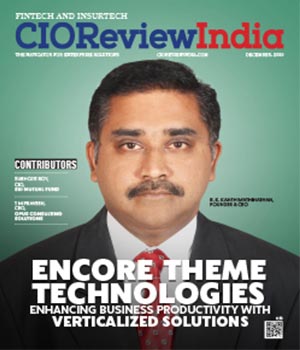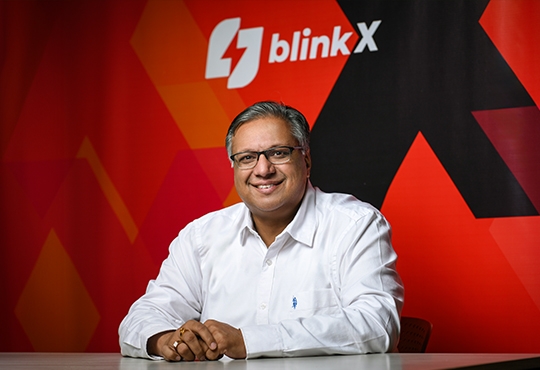
What Is The Future Scenario Of Digital Payment
CIOReviewIndia Team | Monday, 16 November 2020, 07:18 IST
 In recent times, there have been a lot of changes made in the way transaction takes places. From what started with ATM and Net Banking, is now today has become a billion-dollar business with fintech and banks leveraging technology and facilitating easy digital/electronic payment procedures.
In recent times, there have been a lot of changes made in the way transaction takes places. From what started with ATM and Net Banking, is now today has become a billion-dollar business with fintech and banks leveraging technology and facilitating easy digital/electronic payment procedures.
For serving the communities, businesses adopted hassle-free and robust technologies only for payments, however, today, technology is transparent with traditional monetary transactions, where every payment dwelled with the challenges like accountability, accessibility, mobility, and security.
In the past four to five years, the digital payment market witnessed huge developments, and this decade is predicted to witness furthermore advancements, with the modern-day cybersecurity technologists started making sure that the payments completed are secured.
Stats suggest that the global e-wallet transaction reached a whopping US$4,296 billion in 2018 and it is estimated to reach US$13,979 billion by 2022, the enthralling optimum interest of the consumer-end to digital payment.
What 2020 Offered In Terms Of Advanced Digital Payment Technologies?
- Authentication Through Biometrics
In between attacks from the novel coronavirus, with increasing practice of social distancing, biometric authentication emerged, with verification methods involving biological and structural characteristics of a human. It includes fingerprint scanners, facial recognition, iris recognition, heartbeat analysis, and vein mapping.
As there is an increase in theft and fraud-related issues, biometric authentication is a reliable and secure option for digital payments in 2020, and the following years. Experts suggest from industry data that there will be 18+ billion biometric transactions by 2021.
Biometric authentication, integrating and providing accuracy, efficiency, and security within a single package, is a more unique, essential, and much-secured mode of payment.
Biometric payment gains customer loyalty and trust with its unique approach to an individual’s characteristic recognition.
- AI-Powered Security
A foremost factor for hassle-free digital payments is security. Consumers are in constant fear of data/finance loss and search for a secure payment method with top-notch security. Payment technologists need to develop a highly functional security system to leverage digital payment technology.
There are consumer details and transaction data to a financial institution in huge numbers every day and for identifying threats in minimum time, these institutions are ensuring emerging technologies like artificial intelligence (AI) and machine learning (ML) are integrated into the security system.
Machine learning, the most important application by AI, is the first step towards securing a transaction, and financial institutions are constantly updating their software with unique transactions, with the software becoming efficient in learning about fraud transactions in real-time, thereby limiting the risks, and detecting any threats.
- No Contact/NFC Payments
Contactless payments increased faster than before in 2020, by allowing users to complete payments swinging their smartphones over codes, which became more frequent than swiping a card.
Regarded as a more convenient and secure payment process compared to PIN technology, no contact payment transfers the data which is encrypted to the point-of-sale device instantaneously.
Tech giants like Google, Apple, and Samsung have developed contactless payment applications like Google Pay, Apple Pay and Samsung Pay respectively. With customers adding card details for registering their payment details in an application, they can simply complete a transaction by swinging the phone over the code.
No contact payments are only possible with near-field communication (NFC) technology, which is why the payments are called ‘NFC Payments’
Countries like the UK, Japan and China have included NFC payments, and London and China have implemented NFC payments in public transport and tube stations. Japan implemented this technology for providing information about identity cards.
In fact, the United Kingdom finance represents a cluster of financial institutions, which projected that almost 36 percent of total payments will be done through NFC – infused contactless cards by 2027.
- E-wallet Cryptocurrency
Amidst fluctuating the fluctuating market in COVID-19, cryptocurrency wallet users increased with time, and 40+ million cryptocurrency-based eWallets became real from the start of 2020.
According to Statista reports, the total number of cryptocurrency wallet users went up to 34.6 million in the first quarter of 2019 from 6.7 million in the first quarter of 2016.
Though buying cryptocurrencies using e-wallets imply cryptocurrency investments, a user needs a digital wallet to store the digital currency it purchased.
- Codes
Previously, bank accounts were determined by a random combination of unique digits from a card. The Europay, Mastercard, Visa (EMV) technology moved further and introduced a highly functioning automated and secured payment mechanism. EMV technology is renowned for using codes that shuffle at every unique transaction. Using this temporary code, it is improving the security in the banks, and the instance indicates codes can shape the way a bank account system is handled.
Also, cutting-edge payment services offer more convenient and seamless money transfer methods and stores, overshadowing the future of plastic cards.
In conclusion, we can say that e-wallets are the future, wherein the coming years, payment methods will be transitioned from physical cash to digital payment. While the transition is on, there will come a lot of trends and play an important role in defining the future of payment methods.
CIO Viewpoint
Making Informed Financing Decision and Reducing...
By Abhishek Sharma, Chief Digital Officer, L&T Financial Services
Financial Services Sector Progresses Towards...
By Ravi Kethana, Chief Platform Officer, CAMS
Making Financial Services Industry Digital-first
By Dhaval Pandya, Corporate CIO, Piramal Enterprises Limited
CXO Insights
Unveiling FinTech Trends for 2024: Letting the...
By Sameer Danave, Senior Director Marketing, MSys Technologies
The Role of Big Data in Market Forecasting
By GaganSingla, MD, Blinkx
Budget 2023: Measures that will help the IT...




.jpg)
.jpg)




